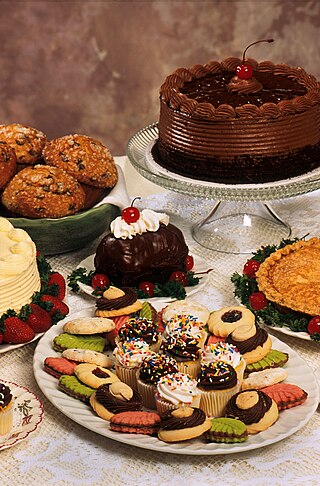
Dessert is a course that concludes a meal. The course consists of sweet foods, such as candy, and possibly a beverage such as dessert wine and liqueur. In some parts of the world, such as Greece and West Africa, and most parts of China, there is no tradition of a dessert course to conclude a meal.

Caramel is an orange-brown confectionery product made by heating a range of sugars. It can be used as a flavoring in puddings and desserts, as a filling in bonbons, or as a topping for ice cream and custard.

A crêpe or crepe is a very thin type of pancake. Crêpes are usually one of two varieties: sweet crêpes or savoury galettes. They are often served with a wide variety of fillings such as cheese, fruit, vegetables, meats, and a variety of spreads. Crêpes can also be flambéed, such as in crêpes Suzette.

Crème caramel, flan, caramel pudding, condensed milk pudding or caramel custard is a custard dessert with a layer of clear caramel sauce.

Guanajuato, officially the Free and Sovereign State of Guanajuato, is one of the 32 states that make up the Federal Entities of Mexico. It is divided into 46 municipalities and its capital city is Guanajuato.
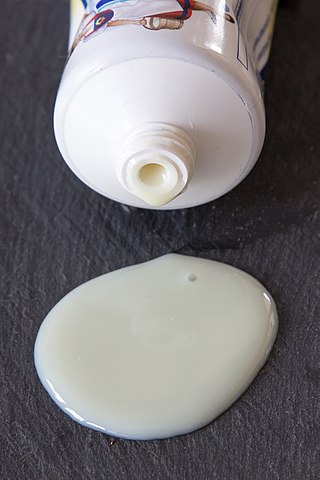
Condensed milk is cow's milk from which water has been removed. It is most often found with sugar added, in the form of sweetened condensed milk (SCM), to the extent that the terms "condensed milk" and "sweetened condensed milk" are often used interchangeably today. Sweetened condensed milk is a very thick, sweet product, which when canned can last for years without refrigeration if not opened. The product is used in numerous dessert dishes in many countries.
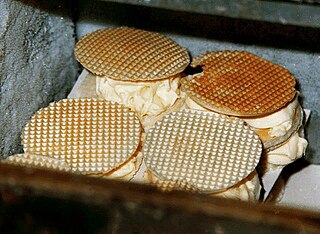
A wafer is a crisp, often sweet, very thin, flat, light biscuit, often used to decorate ice cream, and also used as a garnish on some sweet dishes. Wafers can also be made into cookies with cream flavoring sandwiched between them. They frequently have a waffle surface pattern but may also be patterned with insignia of the food's manufacturer or may be patternless. Some chocolate bars, such as Kit Kat and Coffee Crisp, are wafers with chocolate in and around them.

Dulce de leche, also known as caramelized milk, milk candy or milk jam in English, is a confection popular in Latin America prepared by slowly heating sugar and milk over a period of several hours. The resulting substance, which takes on a spreadable, sauce-like consistency, derives its rich flavour and colour from non-enzymatic browning. It is typically used to top or fill other sweet foods.

Rice pudding is a dish made from rice mixed with water or milk and other ingredients such as cinnamon, vanilla and raisins.
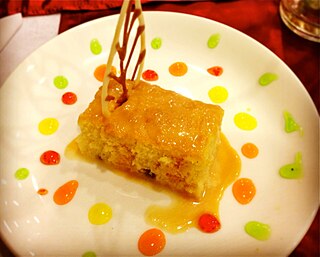
A tres leches cake, dulce de tres leches, also known as pan tres leches or simply tres leches, is a sponge cake—soaked in three kinds of milk: evaporated milk, condensed milk, and whole milk.

Manjar blanco, also known as manjar de leche or simply manjar, is a term used in Spanish-speaking areas of the world in reference to a variety of milk-based delicacies. In Spain the term refers to blancmange, a European delicacy found in various parts of the continent as well as the United Kingdom. In the Americas it refers to a sweet, white spread or pastry filling made with milk. This term is sometimes used interchangeably with dulce de leche or cajeta in Latin America but these terms generally refer to delicacies prepared differently from those just described. Related dishes exist by other names in other countries, such as tembleque in Puerto Rico. In Portuguese-speaking countries the dish is known as manjar branco.
Quesillo refers to different Latin American, Spanish, and Filipino foods or dishes depending on the country:

Palapa Azul is a frozen desserts company based in Los Angeles, California. The company, founded in 2002 by Mexico City natives Michel Algazi and Roni Goldberg, produces Mexican-style ice cream, sorbet, and frozen fruit bars that are sold in retail stores throughout the United States. Palapa Azul is also a member of NASFT.
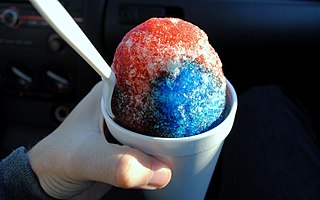
Shaved ice is a large family of ice-based desserts made of fine shavings of ice or finely crushed ice and sweet condiments or syrups. Usually, the syrup is added after the ice has been frozen and shaved—typically at the point of sale; however, flavoring can also be added before freezing. The dessert is consumed worldwide in various forms and ways. Shaved ice can also be mixed with large quantities of liquid to produce shaved ice drinks.

Krówki, literally meaning "little cows," are Polish fudge, semi-soft milk toffee candies. When hand-made, they are hard and crispy on the outside, but the inside is more fluid than solid.

Ecuadorian cuisine is diverse, varying with altitude and associated agricultural conditions. Ecuadorian cuisine is an amalgamation of Spanish, Andean, and Amazonian cuisines and to a lesser degree Italian, Lebanese, African, and Chinese. Beef, chicken, and seafood are popular in the coastal regions, especially ceviche, and are typically served with carbohydrate-rich foods, such as rice accompanied with lentils, pasta, or plantain. In the mountainous regions pork, chicken, beef and cuy are popular and are often served with rice, maize, or potatoes. A popular street food in mountainous regions is hornado, consisting of potatoes served with roasted pig. Some examples of Ecuadorian cuisine in general include patacones, llapingachos, and seco de chivo. A wide variety of fresh fruit is available, particularly at lower altitudes, including granadilla, passionfruit, naranjilla, several types of banana, uvilla, taxo, and tree tomato.
The following outline is provided as an overview of and topical guide to chocolate:

Flan cake, also known as leche flan cake or crème caramel cake, is a Filipino chiffon or sponge cake (mamón) baked with a layer of leche flan on top and drizzled with caramel syrup. It is sometimes known as "custard cake", which confuses it with yema cake. Modern versions of flan cake can be cooked with a variety of added ingredients. An example is the use of ube cake as the base.



























